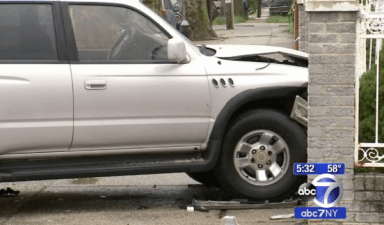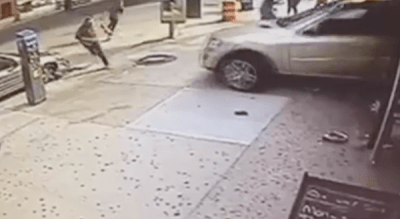100 Years Ago, Hit-and-Run Was a Felony in New York. Could It Be Again?

As mentioned in Street Justice last week, legislation has been proposed that would create felony liability in some cases where a driver flees the scene after seriously injuring or killing a person. At present, leaving the scene of a crash is a misdemeanor, often a class B misdemeanor punishable only by a fine of $250.00. That’s less than the fine for running a red light. That we attach so small a consequence to the outrageous act of injuring a person and leaving them in the road to die is positively shameful.
Could the New York State legislature actually take the dramatic step of making hit-and-run a felony? Why not? After all, when the problem of hit-and-run motorists first emerged 100 years ago, it was a felony.
Back in 1909, the New York State legislature was in the process of developing comprehensive regulations governing motor vehicles on public roadways. Motor vehicles were newcomers to the traffic mix, but were clearly in ascendance as a must-have item for the wealthy and powerful. New York City’s upper class was believed to own approximately one-third of the entire 8,000-automobile U.S. fleet at the turn of the century.
One of the new motor vehicle laws enacted in 1909 was “leaving the scene of an accident” by the operator of a motor vehicle, which was made punishable as a felony, with up to two years of imprisonment:
“Any person operating a motor vehicle, who, knowing that injury has been caused to a person or property . . . leaves the place of said injury or accident, without stopping and giving his name, residence, including street and street number, and operator’s license number to the injured party, or to a police officer . . . shall be guilty of a felony punishable by a fine of not more than five hundred dollars or by imprisonment for a term not exceeding two years, or by both such fine and imprisonment.”
Under this law, well-heeled hit-and-run drivers spent small fortunes avoiding felony convictions. One driver, Raymond J. Curtis, struck the driver of a horse-drawn carriage, permanently disabling him, and then drove off. Curtis was convicted as a felon under the 1909 hit-and-run law, but reversed the conviction after two appeals, and obtained a second trial. The second jury also convicted Curtis, and the conviction stuck, despite two more appeals.
For Curtis, the cost of all this litigation was probably at least 20 times the maximum fine of $500 — a small fortune in those days. This seems a fair indication that Curtis faced a significant prison term and other unpleasant consequences as a convicted felon, demonstrating the powerful impetus on behavior of serious criminal penalties.
Other early 20th century drivers actually mounted constitutional challenges to hit-and-run and mandatory identification tag statutes, in a bid to avoid crash liability. The drivers argued that these laws forced drivers to incriminate themselves in violation of the Fifth Amendment and other similar protections, because a mandatory license plate in effect compelled a “statement” as to drivers’ identities at crash scenes, and the reporting provision of hit-and-run laws compelled drivers to “admit their guilt” to police.
This legal strategy to evade responsibility for crash victims was settled in the 1913 case of People v. Rosenheimer, decided by the New York Court of Appeals — then regarded as one of the most influential state courts in the nation.
The Rosenheimer court’s opinion records the contemporary views of motor vehicle traffic, not yet inured by decades of motoring. The court observed that it was “too clearly a matter of common knowledge to justify discussion” that “the motor vehicle, on account of its size and weight, of its great power and of the great speed which it is capable of attaining” creates “a most serious danger . . . both to other travelers on the highway and to the occupants of the vehicles themselves,” unless “managed by careful and competent operators.” Moreover, it is “necessary that the vehicle may be readily identified, to deter the operator from violating the law and the rights of others, and to enforce the laws regulating the speed, and to hold the operator responsible in cases of accident.”
From this the court drew a simple conclusion: The “fatalities caused by [motor vehicles] are so numerous as to permit the legislature, if it deemed it wise, to wholly forbid their use. . . . In operating a motor vehicle the operator exercises a privilege which might be denied him, and not a right, and that in a case of a privilege the Legislature may prescribe on what conditions it shall be exercised.”
The Rosenheimer court upheld the constitutionality of New York’s hit-and-run law, while coining the familiar adage that “driving is a privilege, not a right.” This willingness 100 years ago to enact and uphold a law that sent wealthy and powerful New Yorkers to prison spoke volumes about the tremendous value that New Yorkers of the time place on the rights of crash victims.
But by 1929, things changed. New York’s law was amended to make hit-and-run a misdemeanor punishable by up to 60 days in jail. Why did New Yorkers decide in the 1920s to take hit-and-run drivers less seriously? It certainly was not due to a decrease in the number of serious auto crashes. Rather, the rapid expansion of car ownership meant that an increasing number of the voting public saw themselves as more likely to be behind a wheel than under one.
Having largely organized our culture around high-risk automobile travel for a century now, we presumably are that much more inured to traffic violence than lawmakers in 1929, and even less likely to re-classify hit-and-run as a felony. But the tragic death of the Glauber family and the driver’s cowardly flight from the scene once again force us to ask: What will it take to reinstate serious criminal penalties for hit-and-run in New York State? Let’s watch the progress of S-4060-2013 through the legislature and see.


